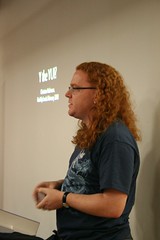 This week Leeds Met's co-working start-up facility Met:space hosted a GeekUp talk from Christian Heilmann who is a web architect for Yahoo! UK. GeekUp Leeds like OpenCoffee provides a chance for 'grassroots geekery' - web developers and creative technologists meeting up for an informal chat, networking and a space to share ideas.
This week Leeds Met's co-working start-up facility Met:space hosted a GeekUp talk from Christian Heilmann who is a web architect for Yahoo! UK. GeekUp Leeds like OpenCoffee provides a chance for 'grassroots geekery' - web developers and creative technologists meeting up for an informal chat, networking and a space to share ideas.Christian's talk 'Yahoo UI - Javascript Evolved?' gave an overview of the YUI toolkit, describing how Javascript libraries can simplify web development - letting people focus on innovations in their design rather than browser bugs and basic functionality.
He talked about how a key skill he has been seeking out in recruiting for Yahoo development teams is an ability to program for others rather than just yourself.
 He looks for developers who can write logical code that can then be passed to Yahoo teams elsewhere in the world without difficulty. Toolkits like YUI help to do this by organising namespaces, interface elements and plug-in widgets for rich interactive web interface design.
He looks for developers who can write logical code that can then be passed to Yahoo teams elsewhere in the world without difficulty. Toolkits like YUI help to do this by organising namespaces, interface elements and plug-in widgets for rich interactive web interface design.The event was packed and interesting. Thanks to the GeekUp team and the NTI for organising the event.






